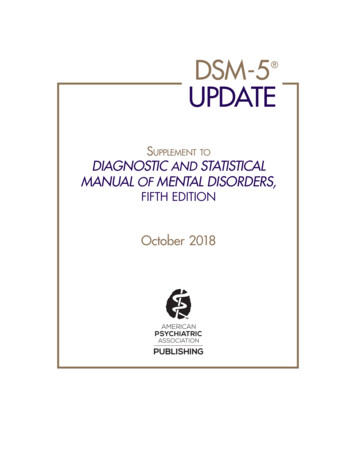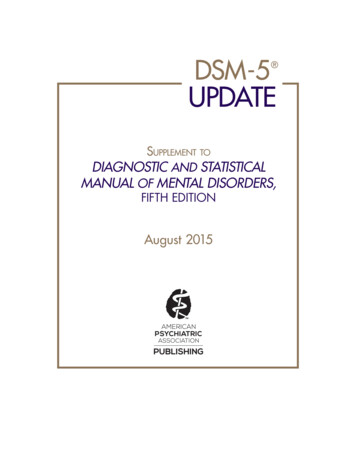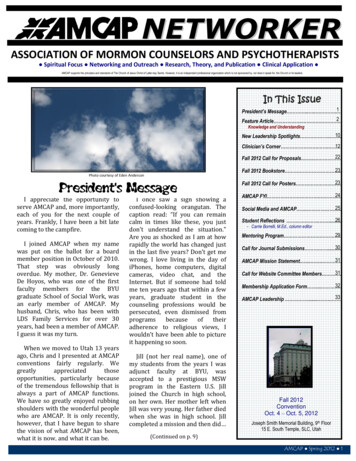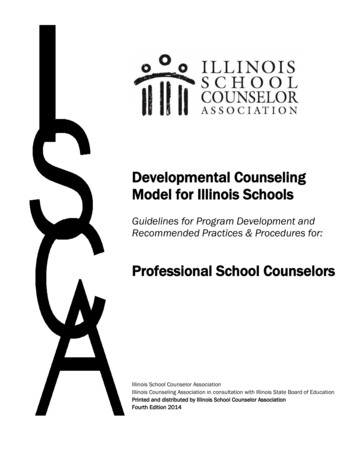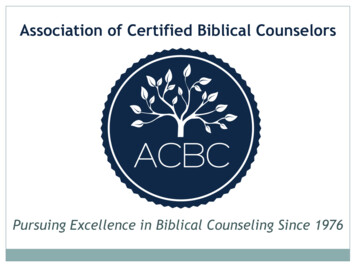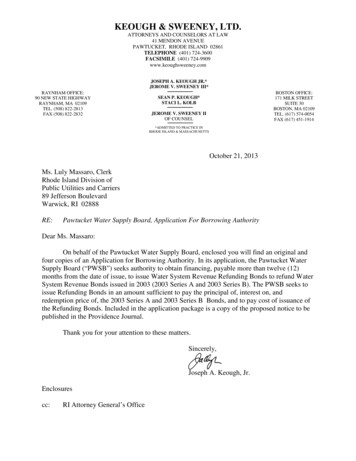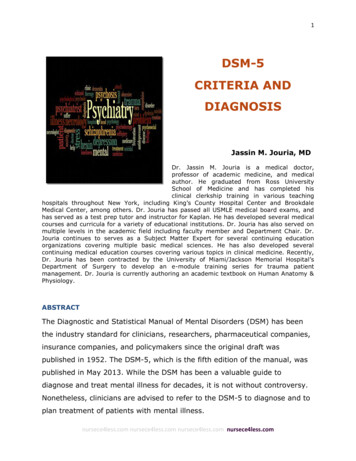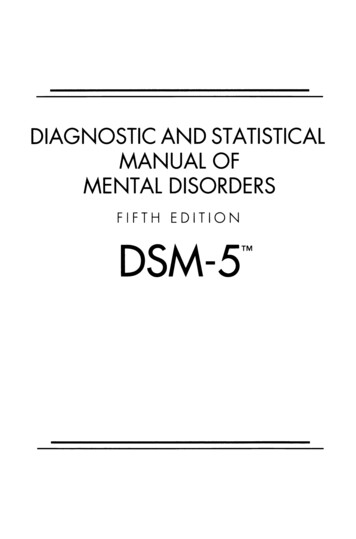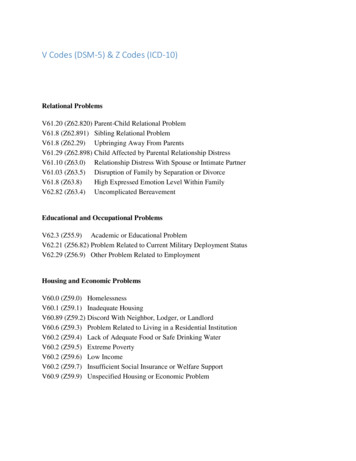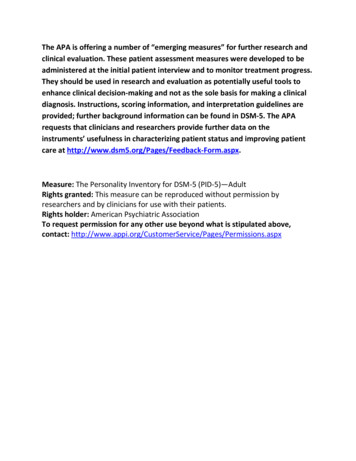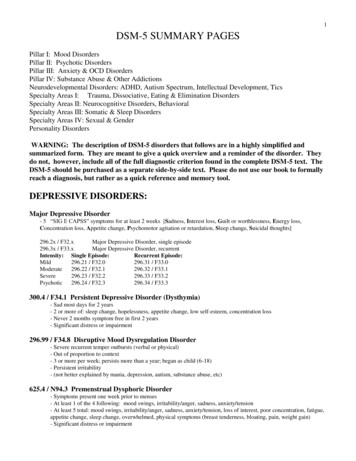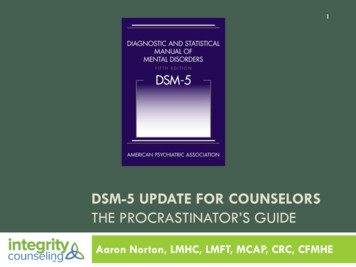
Transcription
1DSM-5 UPDATE FOR COUNSELORSTHE PROCRASTINATOR’S GUIDEAaron Norton, LMHC, LMFT, MCAP, CRC, CFMHE
About the Presenter2Mr. Norton is a Licensed Mental Health Counselor, LicensedMarriage & Family Therapist, Certified Master’s-LevelAddictions Professional, Certified Rehabilitation Counselor, andCertified Forensic Mental Health Evaluator working in privatepractice at Integrity Counseling, Inc. in Largo, FL, where hespecializes in mental health and substance abuse evaluationsand integrative therapy for anxiety, depressive, and addictivedisorders. He provides professional consultation and training,and as a Qualified Supervisor he offers clinical supervision forRegistered Mental Health Counselor Interns. He is the PastPresident and Chair of Public Relations of the Suncoast MentalHealth Counselors Association, Chair of the Florida MentalHealth Counselors Association’s Education Committee, Chair ofthe National Board of Forensic Evaluator’s Training Standards &Implementation Committee, and an Adjunct Instructor in the Dept.of Child & Family Studies at the University of South Florida’sCollege of Behavioral and Community Sciences. He is pursuinga Ph.D. in Counselor Education & Supervision with a cognate inCognitive Health from the University of South Florida.
What We’ll Cover 3 Counselors and the Medical ModelDSM-5 Controversies & CriticismsOverview of Changes (Bird’s Eye View)Overview of Section II Chapter ChangesOverview of Section II Disorder ChangesOverview of Section III ChangesDSM-5 ResourcesQuestion & Answer Session
Why Do We Have a DSM?4 “ to assist trained clinicians in the diagnosis oftheir patients’ mental disorders as part of a caseformulation assessment that leads to a fullyinformed treatment plan for each individual.” (APA,2013)
Counseling and the Medical Model5Medical Model Pathology-orientedTreatment-orientedScientific paradigmDichotomousCounseling Profession Wellness-orientedPrevention-orientedPhilosophic paradigmSpectrum-oriented
But I Hate Labels!6 “Although professional counselors may espouse differenttheoretical orientations, they all tend to work from apreventive, developmental, holistic framework, building onclients’ strengths and assets. Counselors help clients withissues ranging from developmental concerns and problems inliving to issues associated with pathology. Thus, althoughcounselors are trained to work with clients from adevelopmental, wellness-oriented perspective, they oftenare involved in diagnosing and treating mental andemotional disorders, including addictions.”“I treat everyone developmentally, but I want to recognizepathology when it is in the room with me.” –Robin Daniel,Ph.D., LPC, Dean of Student Life, Greensboro College(Newsome & Gladding, 2013)
If It Makes You Feel Better 7 Language is, by necessity and definition, alwayslabeling.Labeling can be used to help people (utilitarian).We label symptoms, not people.Labeling can be thought of as a form of modeldependent realism.DSM-5 makes attempts to stress that statisticalabnormalities and political/cultural dissent are not,by themselves, mental disorders
Looking Back8 1952: DSM-I1968: DSM-II1980: DSM-III1987: DSM-III-R1994: DSM-IV2000: DSM-IVTR2013: DSM-5
The DSM-5 Paradigm Shift9 Conceptualize similar disorders (based on common etiology)as one disorder on a spectrum of severityRecognize the overlap between physical and rderCPsychological
The DSM-5 Paradigm Shift10 Specify whya client’ssymptomsdo notneatly fitinto thecriteria for adisorder
The DSM-5 Paradigm Shift11 Enhance understanding ofcultural anddevelopmental life spaninfluences
The DSM-5 Paradigm Shift12 De-pathologize abnormalbehaviors that do notconstitute a “disorder”
Cleaning Up Some Language13
Overview of Changes14ItemChangeGeneral Medical Condition Another Medical ConditionMulti-axial Classification System DiscontinuedGlobal Assessment of Functioning (GAF) World Health Organization DisabilityAssessment Scale (WHODAS) –Section III DiscontinuedRecommendedAddedmore optionsfor indicatingseverity
Definition of a Mental Disorder15 “A mental disorder is a syndrome characterized by clinicallysignificant disturbance in an individual’s cognition, emotionregulation, or behavior that reflects a dysfunction in thepsychological, biological, or developmental processes underlyingmental functioning. Mental disorders are usually associated withsignificant distress or disability in social, occupational, or otherimportant activities. An expectable or culturally approvedresponse to a common stressor or loss, such as the death of aloved one, is not a mental disorder. Socially deviant behavior(e.g. political, religious, or sexual) and conflicts that are primarilybehavior (e.g. political, religious, or sexual) and conflicts that areprimarily between the individual and society are not mentaldisorders unless the deviance or conflict results from adysfunction in the individual, as described above” (APA, 2013; p.20)
Cautionary Statement for Forensic Use ofDSM-5 (paraphrased by me)16 DSM-5 was created for assessment, case conceptualization, andtreatment planning, not forensic application. Nonetheless, it isused in forensic settings.“When the presence of a mental disorder is the predicate for asubsequent legal determination,” DSM-5 can be helpful if usedproperly. It may also “facilitate legal decision-makers’understanding of the relevant characteristics of mental disorders.”May serve as a “check on ungrounded speculation about mentaldisorders and about the functioning of a particular individual.”“ diagnostic information about longitudinal course may improvedecision making when the legal issue concerns an individual'smental functioning at a past or future point in time.”
Cautionary Statement for Forensic Use ofDSM-5 (paraphrased by me)17 Risks Diagnosticinformation may be misused ormisunderstood “In most situations, the clinical diagnosis of a DSM-5mental disorder does not imply that an individual withsuch a condition meets legal criteria for the presence ofa mental disorder or a specified legal standard.” Use of DSM-5 to assess the presence of a mentaldisorder by those without sufficient training or expertiseis “not advised.”
DSM-5 and ICD18 Codes in the DSM-IVTR were ICD-9CM codes e.g. Generalized Anxiety Disorder (300.02)Because U.S. healthcare providers were required touse ICD-10CM (alphanumeric) codes effectiveOctober 1, 2015, the DSM-5 includes ICD-10CMcodes in parentheses e.g.Generalized Anxiety Disorder 300.02 (F41.1)
What might a DSM-5 diagnosis look like?19 Sample DiagnosisV62.21Problem Related to Current Military Deployment Status301.89Other Specified Personality Disorder (mixed personality features—dependent and avoidant symptoms)327.26Comorbid Sleep-Related Hypoventilation300.4Persistent Depressive Disorder (Dysthymia), With anxious distress, Inpartial remission, Early onset, With pure dysthymic syndrome,ModerateV62.89Victim of Crime278.00Overweight or ObesityWHODAS:63Source: King, J.H. (2013, August). Understanding and using the DSM-5. Counseling Today, 56(2).What two things on this slide would get you into trouble with third party payers?
Overview of Changes20 De-pathologizing e.g. Paraphilic disorders vs. paraphilias, Gender Dysphoria vs.Gender Identity DisorderNew Disorder Classifications to capture individuals who needtreatment but were technically just shy of meeting diagnostic criteria e.g. Mild Neurocognitive Disorder, Binge-Eating D/OCutting back on the number of diagnoses per client by providingmore specifier optionsReducing the “Not Otherwise Specified "category due to greaterdepth of detail about symptoms “Other Specified” or “Unspecified”
Just a Review 21Validity Measures what itpurports to measureFace Validity Construct Validity Criterion-RelatedValidity Formative Validity Sampling Validity Reliability Replicability (stableand consistent results)Test-Retest Reliability Parallel Forms Reliability Inter-Rater Reliability Internal ConsistencyReliability Average Inter-Item Correlation Split-Half Reliability
“The goal of this new manual, as with all previous editions, is to providea common language for describing psychopathology. While DSM hasbeen described as a 'Bible' for the field, it is, at best, a dictionary,creating a set of labels and defining each. The strength of each of theeditions of DSM has been 'reliability' – each edition has ensured thatclinicians use the same terms in the same ways. The weakness is its lack ofvalidity. Unlike our definitions of ischemic heart disease, lymphoma, orAIDS, the DSM diagnoses are based on a consensus about clusters ofclinical symptoms, not any objective laboratory measure. In the rest ofmedicine, this would be equivalent to creating diagnostic systems basedon the nature of chest pain or the quality of fever. Indeed, symptombased diagnosis, once common in other areas of medicine, has beenlargely replaced in the past half century as we have understood thatsymptoms alone rarely indicate the best choice of treatment. Patientswith mental disorders deserve better. ”Thomas Insel, Director, National Institutes of Mental HealthDirector’s Blog, 4/29/13
But then again “Basically anytime you change something, it’s always met with resistance.” - Dr. MaxWiznitzer, a pediatric neurologist for UH Rainbow Babies & Children’s Hospital inCleveland, Ohio (Fox News, 5/21/13)“Today, the American Psychiatric Association's (APA) Diagnostic and StatisticalManual of Mental Disorders (DSM), along with the International Classification ofDiseases (ICD) represents the best information currently available for clinicaldiagnosis of mental disorders. Patients, families, and insurers can be confident thateffective treatments are available and that the DSM is the key resource fordelivering the best available care. The National Institute of Mental Health (NIMH)has not changed its position on DSM-5. As NIMH's Research Domain Criteria(RDoC) project website states, ‘The diagnostic categories represented in the DSM-IVand the International Classification of Diseases-10 (ICD-10, containing virtuallyidentical disorder codes) remain the contemporary consensus standard for howmental disorders are diagnosed and treated.’” – Press Release 5/13/13, Thomas R.Insel, M.D., Director, NIMH, & Jeffrey A. Lieberman, M.D., President-elect, APA
24DSM-5 Structure
DSM-5 Table of Contents25 Section I: DSM-5 Basics Introduction Use of DSM-5 Cautionary Statement for Forensic Use of DSM-5Section II: Essential Elements: Diagnostic Criteria and CodesSection III: Emerging Measures and Models Assessment Measures Cultural Formulation Alternative DSM-5 Model for Personality Disorders Conditions for Further StudyAppendix
Section II: 22 Chapters261.Neurodevelopmental Disorders13.Sexual Dysfunctions2.Gender Dysphoria3.Schizophrenia Spectrum and other Psychotic 14.Disorders15.Bipolar and Related Disorders4.Depressive Disorders16.Substance-Related and Addictive Disorders5.Anxiety Disorders17.6.Obsessive-Compulsive and RelatedDisordersNeurocognitive Disorders - Binge-EatingDisorder18.Personality Disorders7.Trauma-and Stressor-Related Disorders19.Paraphilic Disorders, Gender Dysphoria8.Dissociative Disorders20.Other Mental Disorders9.Somatic Symptoms and Related Disorders21.10.Feeding and Eating DisordersMedication-Induced Movement Disordersand Other Adverse Effects of Medication11.Elimination Disorders22.12.Sleep-Wake DisordersOther Conditions that May be a Focus ofClinical Attention (V and Z Codes)Disruptive, Impulse-Control and ConductDisorders
27Section II Chapter Changes
Section II Chapter Comparison:DSM-IVTR to DSM-528DSM-IV TRDisorders first diagnosed ininfancy, childhood oradolescenceDelirium, Dementia andAmnestic and OtherCognitive DisordersDSM-5DeletedDisorders reorganized underother chaptersRenamedNeurocognitive Disorders
Section II Chapter Comparison:DSM-IVTR to DSM-529DSM-IV TRMental Disorders due toa General MedicalCondition Not DeletedRenamedSubstance Use and AddictiveDisorders(includes Gambling Disorder)
Section II Chapter Comparison:DSM-IV TR to DSM-530DSM-IV TRDSM-5Schizophrenia and Other PsychoticDisordersRenamed“Schizophrenia Spectrum and OtherPsychotic Disorders”Mood DisordersSplit into 2 chapters“Bipolar and Related Disorders“Depressive Disorders”Somatoform DisordersRenamed“Somatic Symptom and RelatedDisorders”Sexual and Gender Identity DisordersBroken into 3 chapters“Sexual Dysfunctions”“Gender Dysphoria”“Paraphilic Disorder”
Section II Chapter Comparison:DSM-IV TR to DSM-531DSM-IV TRAdjustment DisordersOther Conditions that MayBe a Focus of ClinicalAttentionDSM-5Chapter EliminatedMoved to “Trauma andStress-related Disorders”Several Disorders Shiftedto“Other Mental Disorders”
32Section II Disorder Changes
Neurodevelopmental Disorders“Mental Retardation” vs. “Intellectual Disability”33DSM-IV TRMental RetardationSeverityDSM-5Renamed“Intellectual Disability(Intellectual DevelopmentalDisorder”)Determined By“Adaptive Functioning” notIQ score
Specify Severity of Intellectual Disability34 Mild, Moderate, Severe, ProfoundLevels determined by functioning in the followingdomains: Conceptual, Social, and PracticalGlobal Delay: Diagnosis reserved for individualsunder 5 and cannot be reliably assessed.
Communication Disorders35DSM-IV TRDSM-5Expressive LanguageCombines both disordersD/O & Mixed Receptive- into one—LanguageExpressive LanguageDisorderD/OPhonological DisorderRenamed“Speech Sound Disorder”StutteringRenamed“Childhood-Onset FluencyDisorder”
Communication Disorders36DSM-IV TRDSM-5New Diagnosis:“Social (Pragmatic) Communication Disorder”Persistent difficulties in the social cues of verbal andnonverbal communication not to overlap disordersin the Autistic Spectrum Disorder classification
Social (Pragmatic) Communication Disorder37 A. Persistent difficulties in the social use of verbal and nonverbalcommunication as manifested by all of the following: 1. Deficits in using communication for social purposes, such as greetingand sharing information, in a manner that is appropriate for the socialcontext.2. Impairment of the ability to change communication to match contextor the needs of the listener, such as speaking differently in a classroomthan on a playground, talking differently to a child than to an adult, andavoiding use of overly formal language.3. Difficulties following rules for conversation and storytelling, such astaking turns in conversation, rephrasing when misunderstood, andknowing how to use verbal and nonverbal signals to regulate interaction.4. Difficulties understanding what is not explicitly stated (e.g. makingreferences) and nonliteral or ambiguous meanings of language (e.g.idioms, humor, metaphors, multiple meanings that depend on the contextfor interpretation).
Social (Pragmatic) Communication Disorder38 B. The deficits result in functional limitations in effectivecommunication, social participation, social relationships,academic achievement, or occupational performance,individually or in combination.C. The onset of symptoms is in the early developmentalperiod (but deficits may not become fully manifest untilsocial communication demands exceed limited capacities).The symptoms are not attributable to another medical orneurological condition or to low abilities in the domains ofword structure and grammar, and are not better explainedby autism spectrum disorder, intellectual disability(intellectual developmental disorder), global developmentaldelay, or another mental disorder.
Autism Spectrum Disorder39 AutismAsperger’s DisorderChildhood Disintegrative DisorderPervasive Developmental Disorder Single Condition (Different levels of symptom severity - 2 Core DomainsLevel 1, 2 and 3, requiring support, substantial support, very substantialsupport, respectively)Deficits in social communication and social interactionRestricted repetitive behaviors, interests, and activities
Autism Spectrum Disorder40 A. Persistent deficits in social communication and social interaction acrossmultiple contexts, as manifested by the following, currently or by history(examples are illustrative, not exhaustive): 1. Deficits in social-emotional reciprocity, ranging, for example, from abnormaland social approach and failure of normal back-and-forth conversation; toreduced sharing of interests, emotions, or affect; to failure to initiate or respondto social interactions.2. Deficits in nonverbal communicative behaviors used for social interaction,ranging, for example, from poorly integrated verbal and nonverbalcommunication; to abnormalities in eye contact and body language or deficitsunderstanding and use of gestures; to a total lack of facial expressions andnonverbal communication.3. Deficits in developing, maintaining, and understanding relationships, ranging,for example, from difficulties adjusting behavior to suit various social contexts; todifficulties in sharing imaginative play or in making friends; to absence ofinterest in peers.Specify current severity: Severity is based on social communication impairmentsand restricted, repetitive patterns of behavior
Autism Spectrum Disorder41 B. Restricted, repetitive patterns of behavior, interests, or activities, as manifestedby at least two of the following, currently or by history (examples are illustrative,not exhaustive): 1. Stereotyped or repetitive motor movements, use of objects, or speech (e.g. simple motorstereotypies, lining up toys or flipping objects, echolalia, idiosyncratic phrases).2. Insistence on sameness, inflexible adherence to routines, or ritualized patterns of verbalor nonverbal behavior (e.g. extreme distress at small changes, difficulties with transitions,rigid thinking patterns, greeting rituals, need to take same route or eat same foodeveryday).3. Highly restricted, fixated interests that are abnormal in intensity or focus (e.g. strongattachment to or preouccupation with unusual objects, excessively circumscribed orperseverative interests).4. Hyper- or hyporeactivity to sensory input of unusual interest in sensory aspects of theenvironment (e.g. apparent indifference to pain/temperature, adverse response to specificsounds or textures, excessive smelling or touching of objects, visual fascination with lights ormovement).Specify current severity: Severity is based on social communication impairments andrestricted, repetitive patterns of behavior
Autism Spectrum Disorder42 C. Symptoms must be present in the early developmentalperiod (but may not become fully manifest until socialdemands exceed limited capacities, or may be masked bylearned strategies later in life).D. Symptoms cause clinically significant impairment in social,occupational, or other important areas of currentfunctioning.These disturbances are not better explained by intellectualdisability or global developmental delay. Intellectualdisability and autism spectrum disorder frequently co-occur;to make comorbid diagnoses of autism spectrum disorderand intellectual disability, social communication should bebelow that expected for general developmental level.
Autism Spectrum Disorder43 Specify current severity for each of the twopsychopathological domains (deficits in socialcommunication and restricted, repetitive behaviors): Level1: Requiring Support Level 2: Requiring Substantial Support Level 3: Requiring Very Substantial Support
Autism Spectrum Disorder44 Specify if: Withor without accompanying intellectual impairment With or without accompanying language impairment Associated with a known medical or genetic condition orenvironmental factor Associated with another neurodevelopmental, mental,or behavioral disorder With catatonia
Will Some Folks be Left Out?45 “Individuals wit
Mr. Norton is a Licensed Mental Health Counselor, Licensed Marriage & Family Therapist, Certified Master’s-Level Addictions Professional, Certified Rehabilitation Counselor, and Certified Forensic Mental Health Evaluator working in private prac
